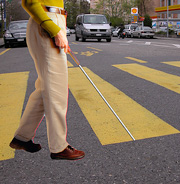
The aim of ISO 23600:2007, Assistive products for persons with vision impairments and persons with vision and hearing impairments - Acoustic and tactile signals for pedestrian traffic lights is to ensure equivalent information worldwide at intersections equipped with pedestrian crossing signals.
The standard sets out the requirements, technical specifications and performance criteria for acoustic and tactile signals for pedestrian traffic lights and will help to ensure major benefits such :
- harmonized criteria for manufacturers and designers
- safe, reliable and functional products
- enhanced compatibility between products
- common testing methods leading to comparable, reliable test results.
Acoustic and tactile signals should be used in combination to provide information such as precise directional information and the geometry of the intersection. The signals can indicate for disabled persons features such as the:
- presence and location of a push button
- location of a pedestrian crosswalk
- walk initiation period
- direction of the pedestrian crosswalk
- prohibited walk initiation period.
At an intersection that is not equipped with acoustic and tactile signals, persons with vision impairments are forced to use the sounds of vehicular traffic when possible in order to estimate the time to start crossing a street and to determine their direction of travel.
In the case of persons with vision and hearing impairments, the majority of these people have to rely on assistance. The installation of acoustic and tactile signals for pedestrian traffic lights based on ISO 23600:2007 significantly improves the ability of these persons to travel safely and independently.
ISO 23600:2007, Assistive products for persons with vision impairments and persons with vision and hearing impairments - Acoustic and tactile signals for pedestrian traffic lights was prepared by ISO technical committee ISO/TC 173, Assistive products for persons with disability. It costs 56 Swiss francs and is available from ISO national member institutes (see the complete list with contact details) and from ISO Central Secretariat through the ISO Store or by contacting the Marketing & Communication department (see right-hand column).

